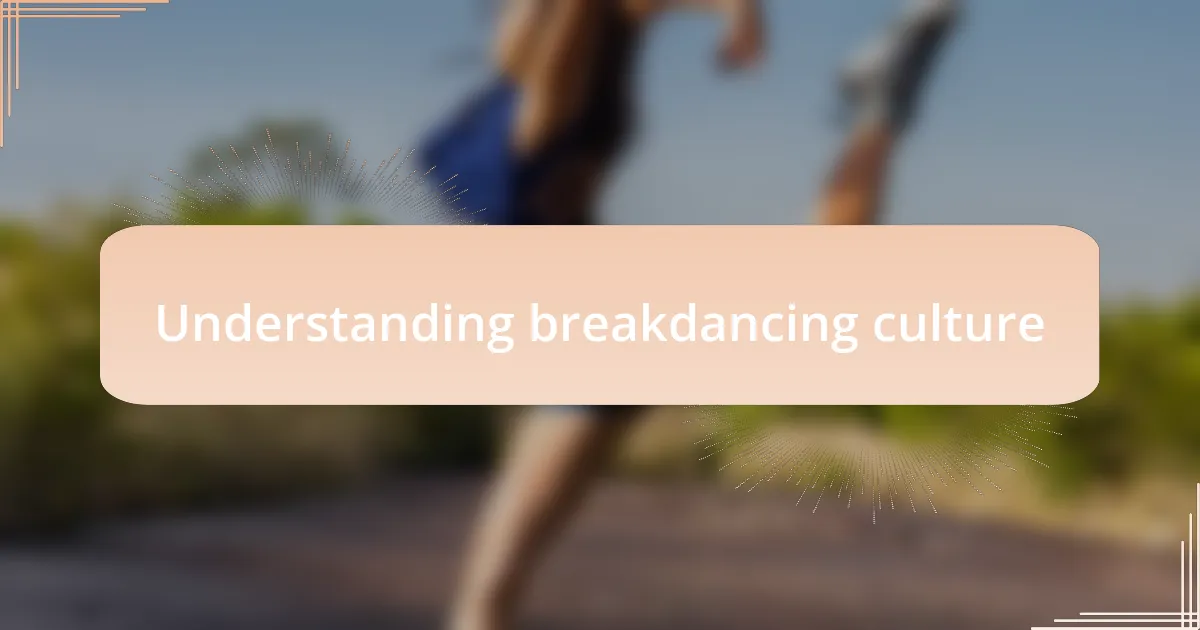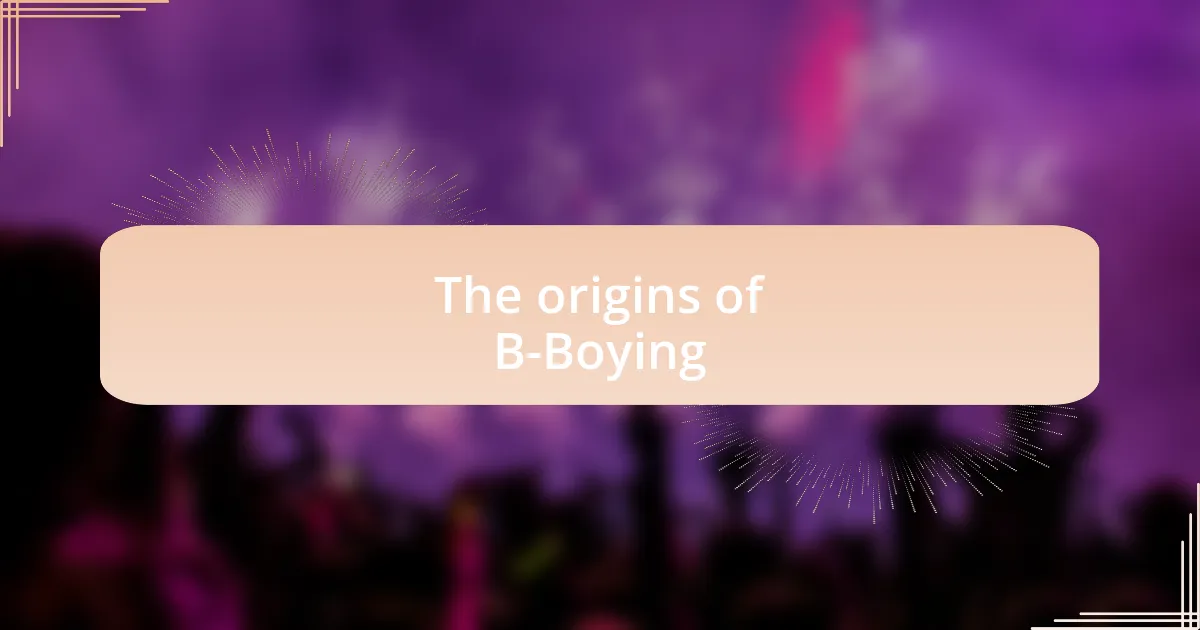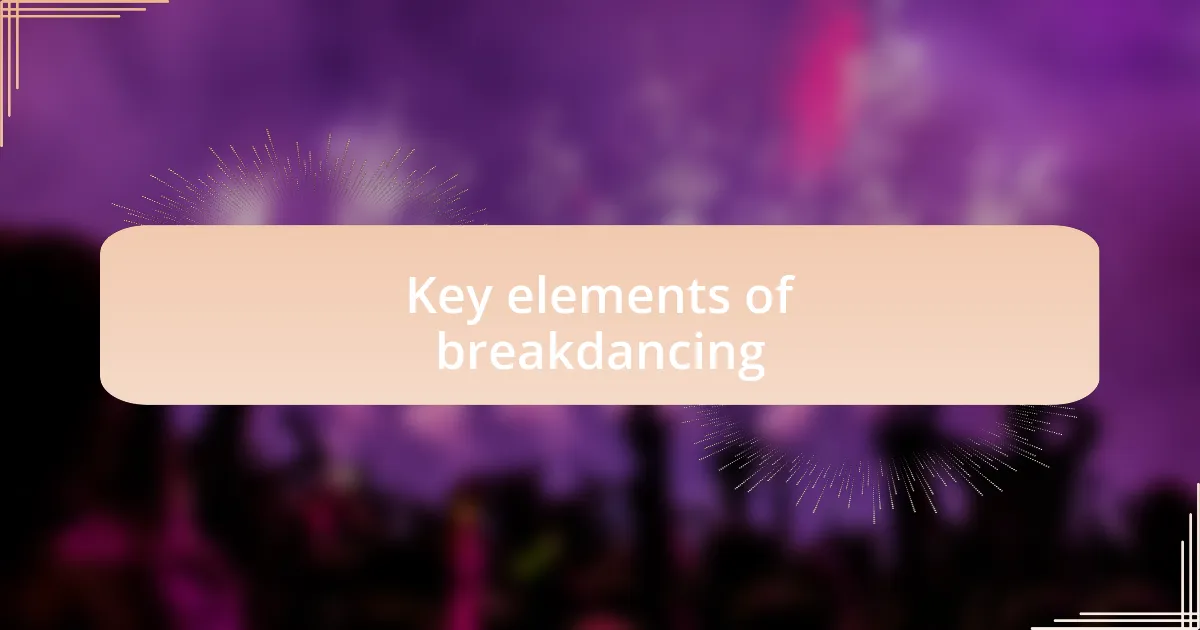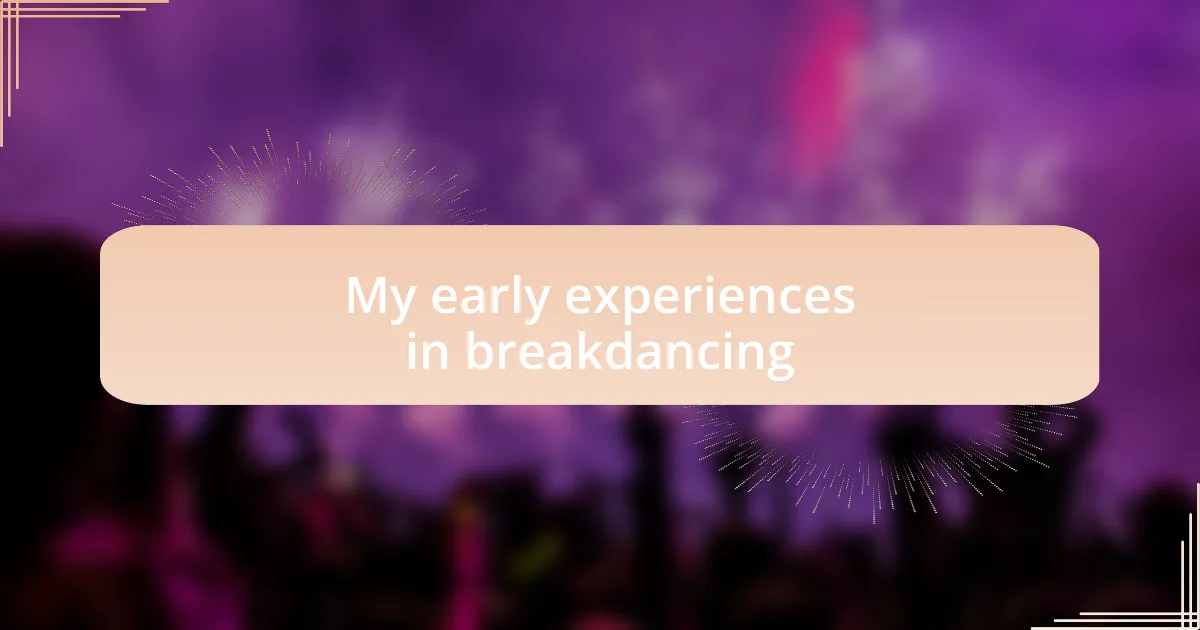Key takeaways:
- Breakdancing culture promotes creativity, resilience, and a sense of community among dancers, fostering mutual support and respect.
- B-Boying originated in the 1970s Bronx, evolving from local block parties into a global phenomenon, influenced by diverse regional styles.
- Key elements of breakdancing include a variety of moves, a strong connection to hip-hop music, and the camaraderie within the B-Boy community.
- Early experiences in breakdancing teach valuable lessons about determination, embracing failure, and being inspired by the talent of others.

Understanding breakdancing culture
When I first stepped into a cypher, the energy was palpable. Surrounded by dancers, I felt an unspoken camaraderie, a shared passion that transcended words. Has anyone ever experienced that electric connection with complete strangers? It’s a feeling like no other, where the music becomes a language we all understand.
Breakdancing culture is rooted in creativity and self-expression. I remember one late night working on my windmills; I kept falling but each attempt had me more determined. This relentless pursuit of improvement not only shaped my skills but also taught me resilience. How many of us can relate to that struggle, balancing pride with the desire to get better?
The community’s spirit thrives on mutual respect and support. I once had an older dancer take the time to share tips with me; it turned into a conversation about our journeys and challenges. Doesn’t that highlight how breakdancing creates bonds that go beyond just moves? The culture is about lifting each other up, celebrating victories, and learning collectively.

The origins of B-Boying
B-Boying traces its roots to the streets of the Bronx in the early 1970s, where urban youth began expressing themselves through dance amidst the backdrop of social and economic challenges. I often think back to how this environment inspired generations to come together, fueled by the beats of hip-hop music. Have you ever considered how a dance form could evolve from a community’s struggles and triumphs?
The style initially emerged as part of block parties, where DJs would spin records and breakbeats, creating the perfect atmosphere for dancers to showcase their talents. I remember watching old footage of battles in neighborhoods; those dancers had an undeniable swagger, blending athleticism with artistic flair. It’s fascinating to realize how their fierce passion laid the groundwork for what we now recognize as a global culture.
As B-Boying spread to other cities, its growth was meteoric, with different regions adding their unique flair and techniques. I felt that shift firsthand during my travels to various dance events, noticing how each scene had its own identity while still honoring the original spirit. Isn’t it amazing how something born in one neighborhood can resonate with so many different cultures and communities worldwide?

Key elements of breakdancing
When I dive into the key elements of breakdancing, the first thing that hits me is the incredible variety of moves that define this art form. From spins to freezes, each dancer’s unique style reflects their personality and creativity. I remember the first time I nailed my first windmill; the rush of accomplishment was overwhelming. Have you ever experienced a moment in dance that made you feel invincible?
Another essential element is the connection to music. B-Boying thrives on the rhythm of hip-hop beats, with dancers intuitively responding to every bass drop and melody. I’ve stood at countless battles, feeling the energy in the air as a DJ selects a track that instantly transforms the vibe; it’s like watching magic unfold. Can you think of a time when a song inspired you to move in ways you never thought possible?
Lastly, the aspect of community cannot be overlooked. The global B-Boy culture fosters camaraderie, support, and competition all at once, creating a space where everyone pushes each other to grow. I’ve made lifelong friends through cyphers and competitions, bonding over our shared passion. Have you ever felt that deep sense of belonging through a shared love for a craft? That connection is what keeps the breakdancing spirit alive and thriving.

My early experiences in breakdancing
I can still picture those early days, standing in a circle with my peers, the noise of the world fading around us as we attempted our first breakdancing moves. I remember struggling to balance on my hands during the first attempts at a Baby Freeze, my palms tingling from the strain, but the encouragement from my friends always pushed me to try again. Can you recall a moment when determination turned your nerves into excitement?
Attending local jams was another unforgettable experience. The first time I walked into a packed venue, I was in awe of the talent around me; the room pulsed with energy and creativity. Watching seasoned dancers effortlessly glide through intricate footwork, I felt both intimidated and inspired—like a novice ready to dive into an ocean of skill. Have you ever found yourself in an environment that completely reshaped your perception of what you could achieve?
As I continued to grow within the breakdancing community, I found that every failed attempt was just a stepping stone towards improvement. One memorable moment was when I tried to replicate a difficult move called the flair but ended up in a heap on the floor instead. Instead of feeling embarrassed, laughter erupted among my friends, and it taught me that embracing failure is as important as celebrating victories. Isn’t it interesting how our missteps can sometimes lead to the most significant lessons?